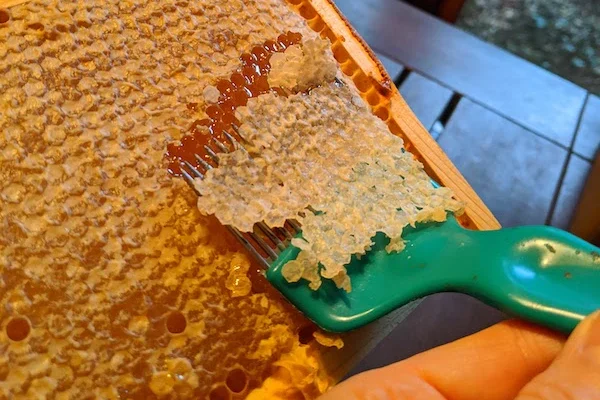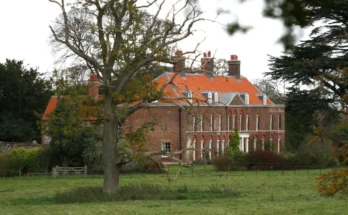Hi, This is Adriana, the beekeeper from South Mountain Bees.
It’s about 7AM on a Sunday morning. Everybody home is sleeping. So I figured this would be a good time to extract the honey that we just harvested a few days ago without interruptions.
A honey frame looks like this. The honey is sealed by the bees with a paper thin layer of beeswax. In order to extract the honey, the first step is to remove that top layer of wax.

I use only mechanical means to remove the beeswax. Some beekeepers use heated knives to shave off the beeswax, but I prefer to avoid heating the honey at any stage of the extraction process to preserve all its beneficial properties. It is more time consuming, but I believe that the end result is worth it.
Therefore I use what’s called among beekeepers an uncapping fork like the one you see here in the picture. It’s clear why it’s called a fork, and it is called “uncapping” because the beeswax covering each hexagon in the honeycomb is called a capping. We often talk about capped honey, meaning that the honey, according to the bees, is ready.

You can see how thin the beeswax is. It takes a lot of frames to gather an ounce of beeswax!
Once all the beeswax is removed, the honey frame looks like this. It’s irresistibly scrumptious.

And the less glamorous part of it is the uncapping fork. You can see that uncapping honey is a sticky and messy process. I use a piece of wood to stand the honey frame while I uncap it, and the cappings fall inside the bucket below it.

The honey frames are two sided, and hence that process has to be repeated on both sides. After 6 frames are uncapped we are ready for the honey extractor. The extractor is a motor powered centrifuge.

The first year we harvested honey we used a manual extractor that we borrowed from our beekeeping club (ECBS). The club has lots of resources so that you can try everything before making an investment in this kind of equipment. The first year of beekeeping can be expensive, and being able to borrow an extractor makes it easy to spread the costs.
Then the fun starts. I’m supposed to keep the lid on, but I wanted to show you, and I was careful not to get my hands too close to the spinning frames. Here you can see the centrifuge running and how the honey flies our of the frames as they spin.
Finally, we open the honey gate, and liquid gold pours out. It’s one of the most satisfying beekeeping moments. As you can see, honey harvesting is a labor intensive process, but this is the most rewarding part of it.
I hope you enjoyed learning about how honey is extracted, and remember that with every soap, every lip balm, and every jar of honey you purchase from us, you are helping Save the bees! Before I go, I have some good news for you. For every 3 bars of soap you purchase you get a free wooden soap dish like this one. No coupon needed. It will be automatically added to your checkout. Sale ends tomorrow!




